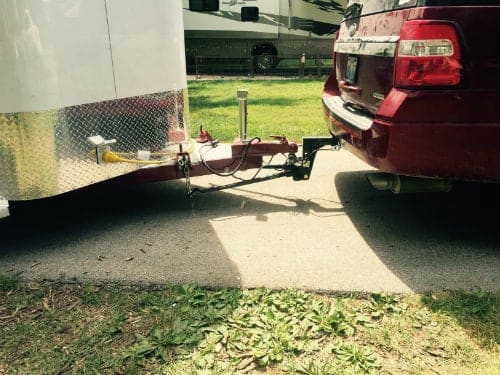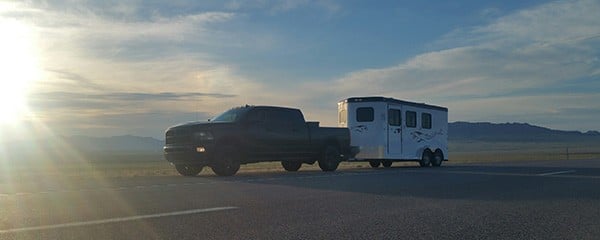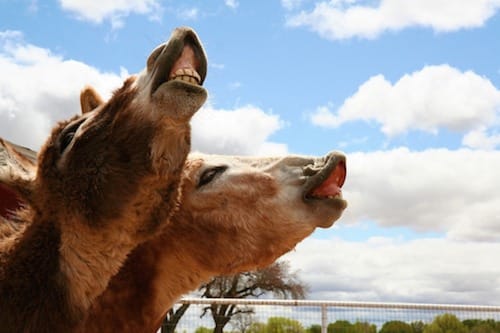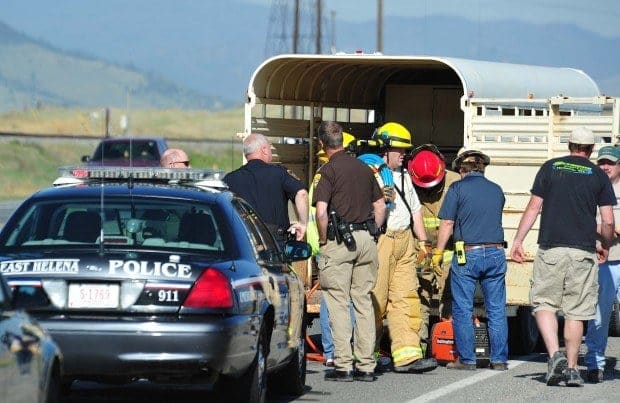10 Tips for Safe Driving With Your Horse Trailer
Hitching up your new trailer for the very first time can be an intimidating experience. It will quickly become clear that you are in a MUCH larger vehicle now traveling along the road with the lives of your family, your horses, and the other drivers in your sweaty palms. Use these ten tips to make sure you are driving safely on the road with your horse trailer. Other drivers …and your horse… will thank you for it!
Check Your Horse Trailer and Tow Vehicle Before You Go
 1. Check that your tow vehicle, hitch, and trailer are well matched and in good working order. It’s very important to have a properly matched trailer, tow vehicle and hitch. A low rated hitch with a heavy trailer is only asking for disaster.
1. Check that your tow vehicle, hitch, and trailer are well matched and in good working order. It’s very important to have a properly matched trailer, tow vehicle and hitch. A low rated hitch with a heavy trailer is only asking for disaster.
Next, check your truck and trailer. You can be the safest driver in the world but that won’t keep you and your horse safe if your rig is a rusty bucket of bolts. Check for broken lights, a faulty emergency brake, damaged safety chains, weak flooring, rusted door latches, or anything else that would compromise the safety of you or your horse during travel.
2. Practice like your horse’s life depends on it. Drive your trailer while it’s unloaded to get a feel for turning, backing, stopping and starting. While you’re at it, have a friend drive your trailer through a field with you in the back. Feeling the bumps from a horse’s point of view will give you more appreciation of how your driving can affect their ability to balance.
Backing is one particular skill that may need some extra practice. Brad Heath, owner of Double D Trailers, recommends, “Get in a large open area without any obstructions (or anyone looking) and take your time to practice. Most folks panic when it comes to backing simply because they have never taken the time to learn in a non-pressured environment.”
Here’s a little secret:
Put your hand on the bottom of the steering wheel to start. If you want the trailer to move to the left, move your hand to the left and vice versa. If you want to make sharp turns while backing, turn the steering wheel before you move the vehicle. If you want to make a more gradual turn, turn the steering while as the vehicle is moving.
How to Prepare Your Horse Trailer for Travel
3. Use smart loading practices. Once you’re confident that your rig is in good shape, it is time to actually load up and set out. Most roads are crowned in the center so it’s a good idea to put the heaviest horse on the driver’s side of a straight load horse trailer. This will help balance the load for even driving. For a slant load trailer, it’s better to load the heaviest part of the load towards the front.
Load your trailer according to how it was designed. Orienting horses backwards in a trailer intended for forward facing horses will change the weight distribution and potentially cause problems.
After you’ve driven a hundred yards, jump out of your truck to make one final check of your trailer and horses. Anything you missed during your loading process will usually make itself apparent during a short drive down the lane.
4. Pack all safety gear for you, your horse, and your vehicle. Driving a horse trailer is a good time to practice strong preparation.
Take along a charged cell phone and first aid kits for you and your horse. Keep a clearly-displayed list of emergency contacts. If you are incapacitated during an accident, the emergency responders can use this list to contact your veterinarian or friends to help attend to your horses. Finally, pack any road safety items you may need like a spare tire, jack, tire iron, chocks, emergency triangles, flashlight, and flares.
How to Safely Drive With Your Horse Trailer
5. Visibility: See and Be Seen. It’s important to have full visibility while driving your horse trailer. Adjust your mirrors so you can see your trailer’s back end and check regularly while on the road. You might consider buying mirror extenders or “fish-eye” mirrors for your truck so you have the best view of what’s going on behind you.
Drive with your low-beams on even during the day so that other drivers can clearly see you. Double D Trailers are equipped with brake lights high up on the rear of the trailer so that more motorists can see when you are braking and have plenty of time to react.

Note your trailer’s tire tracking so you have an idea how closely its tire path follows that of your tow vehicle. Make wider turns to clear barriers. Next, use a lower gear to drive up and down steep hills. Avoid parking on hills, but if you must, use wheel chocks to provide extra securit
Practice good sense by traveling a safe speed for the current road conditions. Don’t be bullied into going faster by traffic behind you. If a long line develops, find a safe place to pull over so cars can pass. Brad added, “Horse trailers are equipped with trailer tires that carry a "ST" designation which stands for "special trailer". Most of those are rated at a maximum speed of 65 MPH. Keep speeds at 55 MPH on two lane roads and no more than 65 MPH on interstate travel.”
7. Know how to deal with trailer sway. First off, a well-engineered trailer (with axles in the proper location) behind an adequately equipped tow vehicle should not sway to the point that correction is needed.
However, if you are in the unfortunate circumstance of trailer sway, lift your foot off the gas pedal to slow down to a safe speed so the sway stops. If the sway is severe (fishtailing) you need to use the hand brake/slider bar on your electronic brake control system inside your tow vehicle to slow down and bring your ride to a stop. The inertia of the tow vehicle trying to move forward against the brakes of the trailer trying to stop should help straighten the sway as you apply the brakes.
Brad added, “Resist the urge to step on the tow vehicle’s brakes….if you do this the inertia of the tow vehicle trying to stop with the trailer pushing forward will only increase the sway and could cause you to lose control.” Afterwards, immediately take action to correct the problem by finding a new trailer, sway bars, better weight distribution, larger tow vehicle, or by reconfiguring the load.
For Your Horse: How to Safely Drive a Horse Trailer

9. Be alert for odd shakes or sounds. Check using your mirrors, keep the radio low and be on alert for any funny sounds or shakes transferred up to your tow vehicle. This may be an indication that your horse fell down or is in some other sort of distress.
10. Be sure the interior of your trailer is comfortable for your horse. The type of trailer you purchase can also make a big difference on the comfort of your horse during travel.
Make sure the interior of the trailer is rattle-proof and well-insulated to provide comfort in hot and cold weather. Brad explained, “Most horse owners may not realize hauling a horse in a "non-insulated" trailer (single skin side wall) is one of the worst things you can do to a horse. Aside from the temperature variation, the trailers are extremely noisy with a lot of sheet metal vibration. So even when temperature isn't a concern in mild climates, the insulation is needed to dampen the vibration.”
Driving a horse trailer on the road is not to be taken lightly. We hope that these ten tips set you well on your way to safe horse trailer driving for many years to come!


